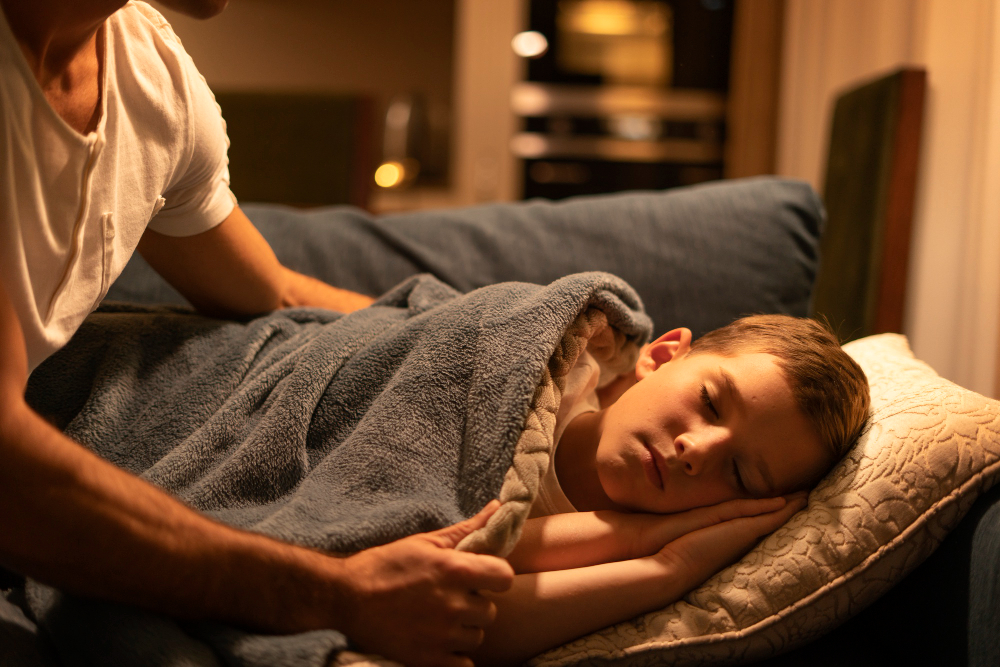How To Put A 2-Year-Old To Sleep In 40 Seconds
Have trouble putting your little ones to sleep? Have you heard about the method of putting a 2-year-old to sleep in 40 seconds?
We understand that it can be a daunting task, but don’t worry; we’ve got you covered!
Sleep is an essential part of your child’s growth and development, and we know you want to ensure that they’re getting enough of it. That’s why we’ve put together some practical and easy-to-apply strategies for parents struggling with bedtime routines.
Whether you’re trying to soothe a fussy baby or coax a restless toddler into dreamland, our tips and insights will guide you every step of the way on how to put a 2-year-old to sleep in 40 seconds.
And the best part? You can achieve success in as little as 40 seconds! So, buckle up and get ready to say goodnight to those sleepless nights!
The Importance of Sleep for Children

Sleep is not just a break from daily activities; it’s a foundational aspect of health. For children, especially, adequate sleep is linked to improved attention, behavior, learning, memory, emotional regulation, quality of life, and mental and physical health.
Without enough sleep, your child may face challenges in school and in their personal development. Establishing a healthy sleep schedule is a critical step in supporting your child’s growth and happiness.
Creating a Soothing Bedtime Routine
Establishing a consistent bedtime routine is essential when it comes to creating a peaceful and relaxing atmosphere for your child. The routine can be as simple as a warm bath, followed by reading a book together and cuddling before tucking them into bed.
Repetition and consistency are crucial in ensuring that your child feels secure and knows what to expect each night. A calming bedtime routine not only helps your child unwind after a long day but also promotes higher-quality sleep, resulting in a more rested and rejuvenated child in the morning.
The Magic of the 40-Second Sleep Method

The 40-second sleep method is a simple yet effective technique that involves a series of comforting actions to help your child drift off to sleep. These actions could include a gentle swaying or rocking motion, a soothing lullaby, or a comforting touch.
The aim is to establish a positive sleep association for your child that can be reinforced over time, making it easier and more natural for them to fall asleep on their own. By consistently practicing this method, you can create a peaceful and relaxing bedtime routine that sets your child up for a good night’s sleep.
Understanding Your Child’s Sleep Needs
Every child has their own sleep requirements that are unique to them. Although there are general guidelines that suggest a certain number of hours of sleep for children of different ages, it is crucial to pay attention to your child’s individual needs.
Observing your child for signs of sleepiness is an important cue to begin the bedtime routine, ensuring that your child does not become excessively tired. This can make it difficult for them to fall asleep at night. Therefore, it is important to be mindful of your child’s sleep patterns and adjust their bedtime routine accordingly.
The Role of a Sleep-Inducing Environment
Getting a good night’s rest is crucial for our mental and physical well-being. By prioritizing these aspects of your sleep environment, you can set yourself up for a peaceful and rejuvenating night’s sleep.
- To ensure a restful sleep, it’s crucial to create a conducive sleep environment. This means investing in a comfortable and supportive mattress that caters to your sleeping position and preferences.
- Additionally, keeping the room temperature cool and comfortable can help regulate body temperature and promote deep sleep.
- To minimize distractions, it’s best to keep the room quiet and dark. However, if you need a little bit of light to feel at ease, a soft and warm night light can provide a sense of comfort without disturbing your sleep.
- Similarly, a white noise machine can be a great tool for masking disruptive sounds and promoting relaxation.
Innovative Tools: White Noise and Lullabies

If you’re struggling with getting your child to sleep, you may want to try using white noise and lullabies.
- White noise is a gentle, continuous sound that can help mask sudden noises that may disrupt your child’s sleep. It creates a calming atmosphere that can help your child feel more relaxed and secure.
- On the other hand, lullabies are soft, melodic tunes that can help soothe your child’s nerves and ease them into a peaceful slumber.
By combining the two, you can significantly enhance the quality of your child’s sleep and ensure they wake up feeling rested and refreshed.
The Gentle Art of Swaddling
Swaddling is a time-tested and effective technique for helping babies drift off to sleep. The snug and secure feeling of being swaddled mimics the sensation of being in the womb, which can help infants feel safe and calm.
However, it’s essential to follow safe swaddling practices to ensure that your baby’s hips and legs can move freely, preventing any potential complications. By following these guidelines, you can help your little one sleep soundly and safely.
Handling Sleep Regression and Night Wakings
Sleep regression is a normal but challenging phase that infants and toddlers go through, usually when they are reaching developmental milestones. It often results in disrupted sleep patterns, frequent night wakings, and overall difficulty in falling asleep.
During these times, it’s essential to maintain a consistent sleep routine and avoid introducing new sleep crutches that can make the situation worse.
You can help your child by gently soothing them when they wake up at night and teaching them how to self-soothe. This can involve gradually reducing the amount of comfort you offer over time and encouraging your child to learn independent sleep skills that will benefit them in the long run.
Sleep Training: When and How to Start
As a parent, one of the challenges you may face is sleep training your child. It’s important to know that sleep training is not a one-size-fits-all approach.
It should only be considered when your child is developmentally ready, usually around 4 to 6 months old. Before starting the process, you should consider your family’s comfort level and your child’s temperament.
There are several methods that you can choose from, each with its own advantages and disadvantages. Gradual methods, such as the chair method or fading, can be less stressful for both parents and children.
- The chair method involves sitting next to your child’s crib as they fall asleep, then gradually moving the chair further away each night until you are out of the room.
- Fading, on the other hand, involves gradually reducing the amount of assistance you provide to your child as they fall asleep.
It’s important to note that sleep training is not a quick fix and may take several weeks to see results. Additionally, it’s crucial to ensure that your child is healthy and not experiencing any underlying sleep issues before starting any sleep training method.
Ultimately, the goal of sleep training is to help your child develop healthy sleep habits and improve the quality of their sleep, which can benefit the entire family.
Common Sleep Issues in Children and Solutions

When it comes to addressing sleep issues in children, it’s important to understand that it often requires a multifaceted approach. Children may experience various challenges with sleep, such as difficulty falling asleep, staying asleep, or resisting bedtime.
In order to address these issues, it’s recommended to make adjustments to the sleep environment, refine the bedtime routine, and ensure that your child feels secure and understood.
One of the first steps in addressing sleep issues is to create a sleep-friendly environment.
- This includes ensuring that the bedroom is cool, quiet, and dark.
- You may also want to consider using white noise or a sound machine to help drown out any external noises that may disrupt your child’s sleep.
- Additionally, it’s essential to make sure that your child’s bed and bedding are comfortable and that the room is free from any distractions, such as electronics or toys.
Another critical aspect of addressing sleep issues is to establish a consistent and calming bedtime routine.
- This may include activities such as reading a book, taking a warm bath, or practicing relaxation techniques such as deep breathing or meditation.
- By establishing a consistent routine, your child will begin to associate these activities with sleep, making it easier for them to fall asleep and stay asleep.
Lastly, it’s crucial to ensure that your child feels secure and understood.
- This means taking the time to listen to any concerns or fears they may have about bedtime and validating their feelings.
- You may also want to consider using positive reinforcement techniques to encourage your child’s progress with sleep, such as praising them for staying in bed all night or falling asleep quickly.
By taking a multifaceted approach and making adjustments to the sleep environment, refining the bedtime routine, and ensuring that your child feels secure and understood, you can help your child overcome any sleep issues they may be experiencing.
The Final Note: How To Put A 2-Year-Old To Sleep In 40 Seconds
- Establish a consistent bedtime routine to signal it’s time for sleep.
- Utilize the 40-second method to soothe your child to sleep quickly.
- Tailor the sleep environment to be as conducive to rest as possible.
- Incorporate tools like white noise and lullabies for added comfort.
- Address sleep challenges with patience, understanding, and consistency.
Getting a good night’s sleep can be a challenging journey for children and parents alike. Every child has a unique path to achieving restful nights, and it can be difficult to know where to start. However, with the right approach, peaceful and restful nights are definitely achievable.
Patience and consistency are key when it comes to helping your child establish healthy sleeping habits. We’d love to hear about your personal experiences and tips in the comments below. Let’s work together to navigate the difficulties of bedtime and promote healthy sleeping habits for our children.
FAQs: How To Put A 2-Year-Old To Sleep In 40 Seconds
Sharing your personal experiences and insights with others who are going through similar challenges can be a powerful way to help them overcome their difficulties. By coming together and sharing our stories, we can foster a supportive and compassionate community that is dedicated to promoting the well-being of our children.
If you are a parent, you know how challenging it can be to put a 2-year-old to sleep. However, some parents have found unique tricks that work for their children.
One such trick is the “How To Put A 2-Year-Old To Sleep In 40 Seconds” technique. While it may not work for every child, it’s always worth a try.
As a parent, it’s essential to share your experiences and tips with others. You never know who might be struggling and could benefit from your advice.







